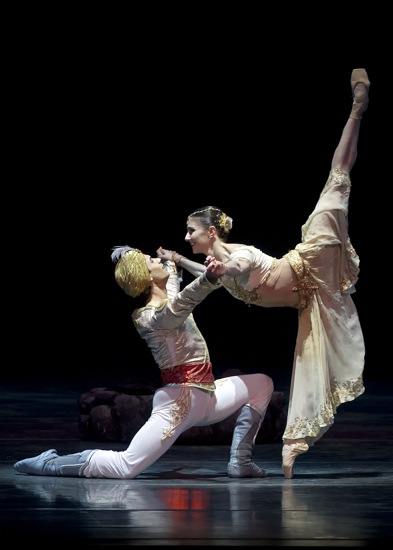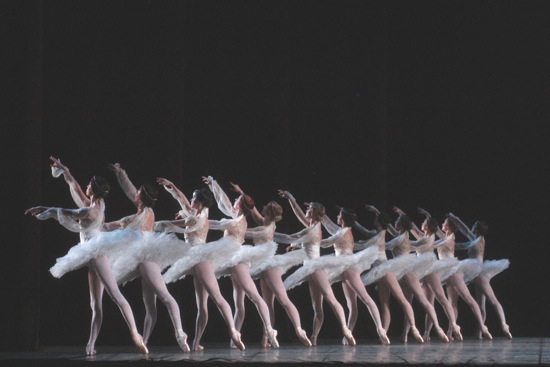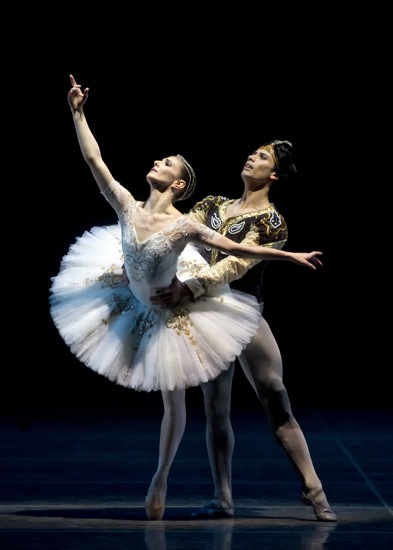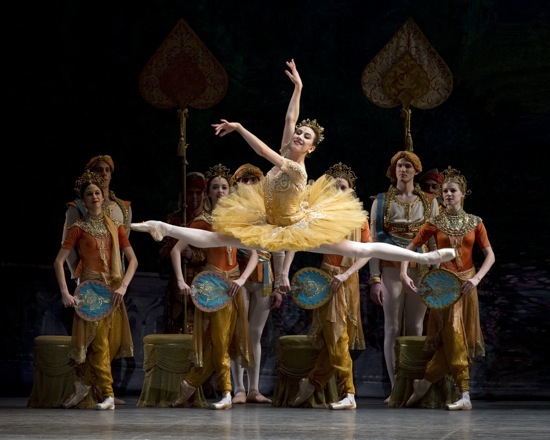People interested in ballet history can entertain themselves with unlikely questions. What, for instance, would Marius Petipa think of the production of his 1877 La Bayadère that the great ballerina Natalia Makarova constructed for American Ballet Theatre in 1980? If he were sitting in a seat at the Metropolitan Opera House during ABT’s current season of classics and new works, how much of the choreography would he recognize as his own?
Makarova wasn’t the first to delete, add to, and alter the ballet. Bayadère today is like a wealthy dowager adorned with generations of jewels: the diamond tiara from her great-great grandmother, her grandmother’s pearls, an aunt’s ruby brooch with a stone missing, a stylish ring her first husband gave her in the 1920s (its emerald turned out to be glass). Yet the ballet, like the grande dame, has the presence, the charm, and the bloodlines to carry it off,
Of course, many decades have passed since 1877. Ekaterina Vazem was much praised for her performance as the original Nikiya, the temple dancer who falls fatally in love with Solor, a warrior in service to an imperious rajah. When you see a photograph of Vazem wearing what appears to be a slim, heavy, mid-calf-length brocade gown, how much impassioned dancing could she have done? Back in the days when the glimpse of a leg could make a gentleman spectator’s heart beat faster and his trousers bulge, she may have seemed sexy. In the filmy harem pants or skimpy tutu designed by Theoni V. Aldredge for Makarova’s version of Bayadère, not much of the ballerina’s body is concealed. (Do not believe, however, that Petipa would have averted his eyes for long).
La Bayadère is one of many 19th-century orientalist ballets. The imagined Near East offered theatrical possibilities: exotic settings and behavior more wanton and violent than would have been proper in a ballet laid in a Bavarian village. Although the work’s plot has similarities to that of Giselle (a foresworn hero meets the ghost of his betrayed beloved amid a bevy of similar dead dancing maidens), its Indian ambiance enables dramatic differences.
Solor doesn’t encounter Nikiya’s spirit; he smokes opium to relieve his guilt and dreams the rest of the glorious Act III. Unlike Giselle, Nikiya doesn’t accept the fact of her lover’s impending marriage to another woman, instantly go mad, and die. When the Rajah’s daughter, Gamzatti, tells Nikiya of her betrothal to Solor, the two women have a bit of a cat fight, in the course of which the temple dancer snatches up a handy knife and goes for her rival. For that, and the embarrassment caused by Solor’s previous liaison, the Rajah orders Nikiya killed in a non-Western, highly suspenseful way, via a poisonous snake concealed in a gift basket of flowers. And in what ballet set in a Christian country would a priest offer to renounce his vows and elope with one of his acolytes?
ABT’s La Bayadère reminds me why audiences love it today. Pierluigi Samaritani’s sets gorgeously evoke 19th-century orientalist painting of crumbling temples, ornate palaces, and pseudo tropical vegetation backed by the Himalayas. Ludwig Minkus’s score, arranged and augmented by John Lanchbery, is often lovely—although Minkus never found a scene too somber or reverent to be composed in waltz time. True, so much mime has been cut in the interests of speeding the action and providing more dancing that it’s easy to miss elements of the plot. The moment in which the High Brahmin offers the dying Nikiya an antidote to the snake venom on condition that she unite with him (she’d rather die) is very blurry. (How did he come by the stuff anyway?) Yet no one seems to mind the inconsistencies.
And the Act III, “Kingdom of the Shades” ballet is a treasure of the classical repertory, one that the ghost of Petipa would certainly recognize. Only in a dream, especially an opium dream, would 24 women in white tutus enter the stage down a ramp one by one and create a snaking path that advances slowly toward the front of the stage, with each dancer repeating the same slow, three-movement phrase over and over. Step into arabesque, fall back and arch the body, take two steps. Again. Again. Again. Once finished and arranged in ranks, the Shades embark on a passage of slow balances in exact unison and tiny bourrées in place that make you imagine they’re stirring the surface of the spirit world as if it were a pond. Before these corps de ballet women take their places at the edges of the stage to frame the action of the principals, they usually receive applause as vociferous as that for the stars. At the performance I saw, the unison was immaculate (one woman wobbled visibly on May 28th, but only slightly), and the three soloists (Sarah Lane, Maria Riccetto, and Yuriko Kajiya) performed their distinctive variations excellently. I was especially struck by Kajiya’s serene and open lyricism.
Bayadère boasts three demanding roles, and ABT’s eight performances featured eight different casts as Nikiya, Solor, and Gamzatti. An acquaintance I chatted with during an intermission had already seen six of them. I was able only to attend the last one before Alexei Ratmansky’s The Bright Stream succeeded it. Alina Cojocaru and Herman Cornejo played Nikiya and Solor as scheduled, while Isabella Boylston took over the role of Gamzatti from Natalia Osipova, who was ill.
Cojocaru is remarkable, one of the great ballerinas of the day. She imbues Nikiya with both spirituality and a kind of innocent wildness in ways that downplay effort and technical expertise. She reaches out a beautifully arched foot with a softness that’s almost feline, and before you see how it happened, she’s standing on pointe. She’s amazingly supple, and by that I don’t mean how far she can arch her body backward; her hip joints might belong to another species of human. When she lifts a leg high, it seems to float into position, without that little ending hitch that says, “I’m there.”
Especially in certain passages, like the mournful solo she performs at Solor and Gamzatti’s engagement party, she plays almost willfully with the music. Yet even when she arrives at a step a hair’s breadth after the beat you expect her to hit, she never seems unmusical; it’s as if, like a jazz singer, she allows herself to weave around and within the melody. Yet, she’s so swift in a spinning passage across the stage in Act III that her image all but blurs.
Her acting is exquisite too. She refuses the High Brahmin’s advances with horror, but also with a kind of embarrassment for him—that he should be willing to break his vows for her. When her requested solo at the engagement party brings her close to where Solor and Gamzatti sit, you can sense in her sudden, slight recoil Nikiya’s shock at seeing the two together for the first time. When she accepts the deadly basket of flowers and begins to dance with it, you can pinpoint the moment when she comes to believe that Solor has sent it to her; her movements become radiant— infused with joy and, perhaps, false hope.
Seeing Cornejo as Puck in Frederick Ashton’s The Dream (coming up June 21), you might not imagine he could be convincing as a princely warrior. But, of course, he aces this too. I was struck by the way, many times, that he pulls himself up, one arm lifted in a gesture that might originally have referred to aiming a bow high. He seems to become a bow himself—tightly strung, ardent, ready to explode. And his rapid, soaring leaps have both an explosive quality and a creamy effortlessness. Whipping off a multiple pirouette, he suspends on balance a second before putting his other foot down. He can do all this without appearing to show off. A true prince.
Solor is a difficult role, not just in terms of the dancing. In the ravishing third-act pas de deux, Cornejo had to concentrate a little too hard on the partnering at the expense of conveying mystified adoration. But he managed beautifully the job of making us try to understand Solor’s love for Nikiya in relation to his fear of the Rajah, his bedazzlement by Gamzatti, and his unfamiliar feeling of helplessness (the absurd dead tiger, given a too short appearance, is meant to affirm his courage and decisiveness).
Boylston is a very strong and accomplished dancer. Her Gamzatti has the required regalness and sense of entitlement. The inner tigerishness is less evident, as is her love of Solor. Yet in the final act, when Solor is torn between his bride and Nikiya’s ghost, and Gamzatti is throwing herself on her father for help, Boylston’s confusion and despair are very moving.
Makarova was right to restore the last act, long out of productions of the ballet. The plot needs wrapping up and the guilty punished (more or less). We’re thrown the dubious treat of the dance of the Bronze Idol (created by Nikolay Zubkovsky for, I believe, the 1941 Russian revival of Bayadère). The choreography is twitchy—angular gestures, and bunched-up jumps—and the makeup is more gold that bronze. Craig Salstein does it to a turn. The lack of rapport between unhappy bride and reluctant groom is nicely expressed by the device of having each stand still in separate wedding-ring circles of dancing attendants. Toshiro Ogawa’s flashing lighting and Minkus’s disaster music help us to believe that the patently fake boulders falling from above are really crushing the temple and everyone in it the moment the High Brahmin weds the couple.
In the apotheosis, Nikiya leads Solor (or rather his spirit) up the remaining staircase—presumably to heaven. She pulls him by the same white scarf, he once held to support her while she, at the other end of it, danced for his pleasure. A fitting conclusion, and magical into the bargain. What do you think, Monsieur Petipa?





While it’s really not possible to second-guess the dead, if M. Petipa is reading this post in the big studio in the sky, where the floor is well-sprung and the rehearsal pianist is paying perfect attention to the choreographer as well as the dancers and the music, I would imagine he’s saying to himself I wish I had been there; this American lady knows whereof she speaks, not only historically but critically as well.
since you mentioned it, the head fakir creeps in from the wings & gives the high brahmin the antidote at some point during nikya’s variation, tho this particular performance is the first time that i have ever noticed it!
lovely review of a brilliant performance 🙂
Thank you, Robin. How smart of you to notice that in the delight of Nikiya’s solo! Now the questions are, how did the fakir come by the antidote and how did he know what the Rajah was planning? Best not to worry perhaps. The fakir network probably knows all.
A very wry and interesting account. What a pleasure to read.
WOnderful writing. Thanks for the report. I really feel like I’ve seen them, Cojocaru and Cornejo, especially — the way their behavior reveals who they are and how they feel. Cojocaru can make you see emotions and realizations arise in her, and you’ve described that so well.
I noticed a few years ago that the Shades phrase is a snippet of the adagio with the basket of flowers — Solor’s hallucination is a recap of what he saw her do just before the snake attacked her, repeated ad infinitum. Petipa was a genius.
I’m grateful, as I’m sure readers of my review are, for Paul Parish’s comment. It’s always wonderful to have one’s attention drawn to an illuminating detail of choreography, hitherto unnoticed. The next time I attend a performance of Bayadère, I’ll do so with refreshed eyes.
I first saw Alina Cojocaru a number of years ago when she made her debut at ABT in La Bayadere with Angel Corella, a perfectly matched pair. I have seen every appearance she has made in NYC since then, not including some galas, but every full length performance, including Ashton’s Cinderella with the Royal Ballet’s Ashton Celebration. I saw her in her four appearances at ABT this summer, including another La Bayadere partnered by Ivan Vasiliev. She has exquisite stage manners and seems to work well with all her partners. She’s currently my favorite ballerina and it does my heart good to read your lovely words about her, as I always trust what you have to say. I hope she’ll return as a guest artist with ABT again next summer. I also hold out hope that the Royal Ballet might visit NYC again and I can see her with her home company, maybe as La Sylphide.
Aw, this was a really nice post. In thought I want to put in writing like this additionally – taking time and precise effort to make an excellent article… however what can I say… I procrastinate alot and in no way appear to get one thing done.
I hope she’ll return as a guest artist with ABT again next summer.